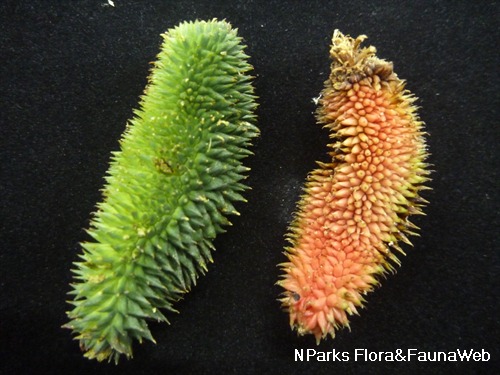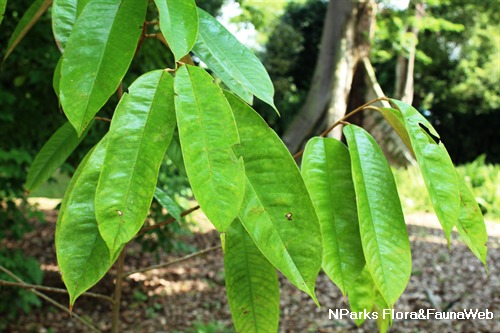.jpg)
Back
Durio singaporensis Ridl.
| Family Name: | Malvaceae |
| Synonyms: | Durio oblongus auct. non Mast.<2> |
| Common Name: | Singapore Durian, Durian Duan |
Durio singaporensis is named after (you guessed it), Singapore! Commonly known as the Singapore Durian, its scientific name takes reference from the distribution of the species; within Singapore and Peninsular Malaysia. The Singapore Durian can grow up to 30 m tall producing thick leathery foliage with a golden-coppery underside. Unlike the Durian commonly eaten (Durio zibethinus), its fruit is densely covered in rambutan-like spines. The brown seeds also lack the yellow, pungent flavoured edible pulp that many enjoy.
Name
Classifications and Characteristics
| Plant Division | Angiosperms (Flowering Seed Plants) (Dicotyledon) |
|---|---|
| Plant Growth Form | Tree (Big (>30m)) |
| Lifespan (in Singapore) | Perennial |
| Mode of Nutrition | Autotrophic |
| Plant Shape | Irregular |
| Maximum Height | 30 m |
Biogeography
| Native Distribution | Peninsular Malaysia and Singapore |
|---|---|
| Native Habitat | Terrestrial (Primary Rainforest) |
| Preferred Climate Zone | Tropical |
| Local Conservation Status | Native to Singapore (Critically Endangered (CR)) |
Description and Ethnobotany
| Growth Form | It is a tall tree that grow up to 30 m tall, small, thin buttresses may be present. It has pinkish red to red brown bark with horizontal ridges. |
|---|---|
| Foliage | Leaves are thick, leathery, oblong measuring from 13-30 cm x 4.8-5 cm, held on an angular petiole 1.5-2.5 cm long. The leaves are dark green, glossy, closely packed scales are found on the underside, giving a golden-coppery appearance. Lance-shaped stipules are found on the tip of the branches, up to 2 cm long, covered in scales on the outside. |
| Flowers | Flowers borne in a short inflorescence along the branches (cauliflorous) with up to 3 flowers per cluster. Flowers are large, white, 5-petalled, with large, loose scales on the outside, velvety on the inside. |
| Fruit | The fruit is a green, round capsule measuring to 11 cm wide, densely covered with slender and stiff rambutan-like spines. Upon maturity, the fruit splits to reveal bare brown seeds, not covered in aril (seed coating). |
| Habitat | It occurs in lowland forests up to 915 m altitude. |
| Associated Fauna | Its flowers are pollinated by bats. |
| Cultivation | It can be propagated by seed. |
| Etymology | Latin Durio, from the Malay name durian; Latin singaporensis, from Singapore, referring to the natural distribution of this species |
Landscaping Features
| Desirable Plant Features | Ornamental Fruits, Ornamental Foliage |
|---|---|
| Landscape Uses | General, Parks & Gardens |
| Thematic Landscaping | Golden Garden |
Fauna, Pollination and Dispersal
| Fauna Pollination Dispersal Associated Fauna | Bat Food |
|---|---|
| Pollination Method(s) | Biotic (Fauna) |
Plant Care and Propagation
| Light Preference | Full Sun |
|---|---|
| Water Preference | Moderate Water |
| Plant Growth Rate | Moderate |
| Rootzone Tolerance | Moist Soils, Well-Drained Soils, Fertile Loamy Soils |
| Propagation Method | Seed |
Foliar
| Foliage Retention | Evergreen |
|---|---|
| Mature Foliage Colour(s) | Green, Yellow / Golden |
| Mature Foliage Texture(s) | Leathery, Thick |
| Foliar Type | Simple / Unifoliate |
| Foliar Arrangement Along Stem | Alternate |
| Foliar Attachment to Stem | Petiolate |
| Foliar Shape(s) | Non-Palm Foliage (Oblong) |
| Foliar Venation | Reticulate |
| Foliar Margin | Entire |
| Foliar Apex - Tip | Acute, Obtuse |
| Foliar Base | Rounded / Obtuse |
Non - Foliar and Storage
| Stem Type & Modification | Woody |
|---|
Floral (Angiosperm)
| Flower & Plant Sexuality | Bisexual Flowers , Bisexual Flowers |
| Flower Colour(s) | White |
|---|
| Flower Grouping | Cluster / Inflorescence |
| Flower Location | Cauliflorous |
| Flower Symmetry | Radial |
| Flowering Habit | Polycarpic |
Fruit, Seed and Spore
| Mature Fruit Colour(s) | Green |
|---|---|
| Mature Fruit Texture(s) | Bristly, Thorny / Spiny |
| Fruit Classification | Simple Fruit |
| Fruit Type | |
| Mature Seed Colour(s) | Brown |
References
| References | <1> Kostermans. A.J. (1959). The Genus Durio Adans (Bombac.), Reinwardtia, 4(3): 106-108. Indonesia: Herbarium Bogoriense. <2> Ridley, H.N (1900). The Flora of Singapore. Journal of the Straits Branch of the Royal Asiatic Society. 33:51. <3> Ridley, H.N (1916). New and Rare Malayan Plants. Series VIII. Journal of the Straits Branch of the Royal Asiatic Society. 73:143. |
|---|
Image Repository
Others
| Master ID | 29703 |
|---|---|
| Species ID | 4012 |





.jpg)
.jpg)
.jpg)
.jpg)



